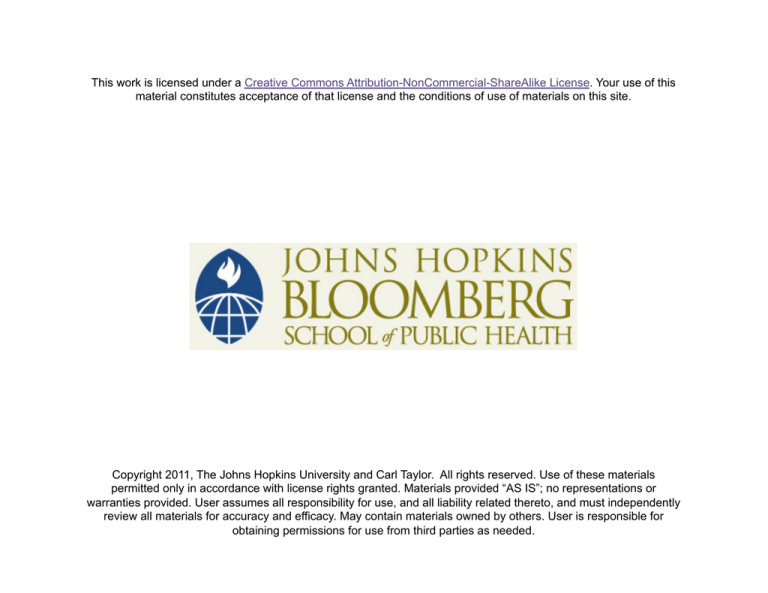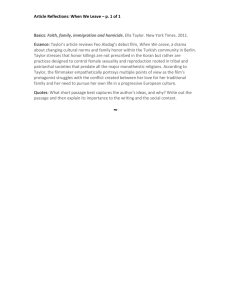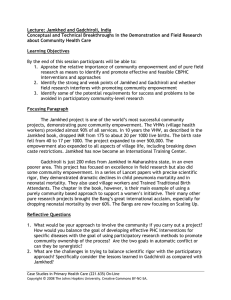
This work is licensed under a Creative Commons Attribution-NonCommercial-ShareAlike License. Your use of this
material constitutes acceptance of that license and the conditions of use of materials on this site.
Copyright 2011, The Johns Hopkins University and Carl Taylor. All rights reserved. Use of these materials
permitted only in accordance with license rights granted. Materials provided “AS IS”; no representations or
warranties provided. User assumes all responsibility for use, and all liability related thereto, and must independently
review all materials for accuracy and efficacy. May contain materials owned by others. User is responsible for
obtaining permissions for use from third parties as needed.
Roots of Primary Health Care:
The Path towards Alma Ata
Carl E. Taylor, MD, MPH, DrPH
Johns Hopkins University
Historical Overview
U.S. clinicians just call it primary care—individual focus
Community-oriented primary care (COPC)
- Started with Kark in South Africa
- Then the United States and Israel
Alma Ata label was primary health care
- At first: comprehensive
- After 1984: selective PHC
Community-based primary health care
- Terminology used by action group which meets each year at the
APHA annual conference to redefine
Seed-scale: future generations integrated community-based social
development
3
Broad Sweep of History
Ancient systems still persist
- China, India, Greece: natural medicines, religious practices,
Shamans
- Babylon public square
Original exchanges in international health
- Similarities amazing—hot and cold foods, spirits, humors,
miasmas, healing practices
Most early systems preventive and integrated
Pre-scientific syncretic and simplistic causes
Hippocrates started separating medicine and public health by
recognizing geographic patterns
4
Indian and Chinese Systems
Classics
- Charaka, Susruta, Vagbhata still used as basic texts for
Ayurvedic system
Chopra commission forced legal recognition but losing battle with
commercial success of Western doctors and pharmaceutical industry
Research on ancient herbs
- Indian national institutes, few successes
For example, Rauwolfia drugs
Now piracy and commercial eradication of plants when production
became profitable
Chinese
- Yellow Emperor’s classic, integration
5
Modern Origins of Primary Health Care
Virchow general idea of
social medicine
Post-World War I Dawson
Report, Peckham health
center and in U.S. social
work centers
Ding Xian, new
paradigm, first
published demonstration
of concept
- We are still trying to
learn how to do and
get accepted
Photo courtesy of the Carl Taylor Collection. Used with permission.
6
Modern Origins of Primary Health Care
Led to Mao’s Barefoot
Doctors for a quarter of
world’s population with
most equitable system
yet devised
- But: collapsed with
Deng Xiao Ping
economic reforms
in early 1980s
- Now severe inequity
—almost as bad as
United States
Photo courtesy of the Carl Taylor Collection. Used with permission.
7
Second- and Third-Generation Projects
Late 1930s to 1950s
- Hydrick, Indonesia
- Stampar, Croatia
- Eloesser, Chile and China
Major historical contribution of Rockefeller Foundation
- Developing centers in Sri Lanka, Kerala, and world to start
formal health systems
Late 1950s
- Kark et al., Pholela, South Africa
1960s to 1970s
- Narangwal Punjab, Fendall Kenya, Geiger U.S. and OEO, Aroles
Jamkhed
1978
- Alma Ata
8
Traditional Practitioners
Constant dilemma of competition resulting in modern practitioners’
labeling them quacks
Anecdotes of spontaneous syncretism, using Western drugs, ancient
practice, they work better
Many studies—especially of TBAs
- Persistence led to efforts to absorb into formal system
- Still major ambiguities
- What happens and why?
What is place in community-based primary health care and in
poorest and most remote areas?
9
How to Make Public Health Routine Work Interesting
Always look for a natural experiment
People—rather than just numbers
Good old days of infectious epidemics
Pat Rubinstein, Massachusetts epidemiologist
10
“When Do I Get up out of My Chair?”
Do I need to do a personal investigation?
Is it time for shoe leather epidemiology?
Where can I make a difference and how?
Discussion
11







